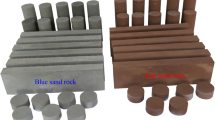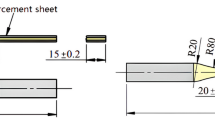Abstract
Carbon fiber-reinforced carbon matrix (C/C) composites are attractive alternative materials for the fabrication of various high-temperature structural components subjected to complex loading conditions. A modified anti-symmetric four-point bending (MAFPB) method for testing a V-notched beam specimen was developed in this study for the investigation of the mechanical behavior of C/C composites under biaxial shear and compression. A finite element model of the specimen was generated to examine the effects of the notch radius and notch spacing on the uniformity and distribution of the stresses in the gauge area. Uniform shear and normal stress were observed in the gauge section of a specimen with a blunted notch and appropriate notch spacing. The three-dimensional (3D) mechanical behaviors of a C/C composite determined by MAFPB tests under pure shear and various biaxial shear–compression stress states were compared with those determined by Iosipescu and off-axis compression experiments. The MAFPB test was found to produce reliable estimates of the mechanical behaviors and failure mechanisms of C/C composites under a wide range of biaxial shear–compression stress states. The shear fracture stress of a 3D C/C composite was particularly observed to significantly decrease with increasing compressive stress component.










Similar content being viewed by others
References
Buckley JD, Edie DD (1993) Carbon-carbon materials and composites. Noyes, Park Ridge, NJ
Windhorst T, Blount G (1997) Carbon-carbon composites: a summary of recent developments and applications. Mater Des 18(1):11–15
Evans AG, Adler WF (1978) Kinking as a mode of structural degradation in carbon fiber composites. Acta Metall 26(5):725–738
Bevilacqua M, Babutskyi A, Chrysanthou A (2015) A review of the catalytic oxidation of carbon–carbon composite aircraft brakes. Carbon 95:861–869
Liu Y, Pei JQ, Li J, He GQ (2017) Ablation characteristics of a 4D carbon/carbon composite under a high flux of combustion products with a high content of particulate alumina in a solid rocket motor. New Carbon Mater 32(2):143–150
Greene, S. E., Shigley, J. K., George, R., & Roberts, R. (2015). Fabrication and testing of low cost 2D carbon-carbon nozzle extensions at NASA/MSFC
Meng, S., Zhou, Y., Xie, W., Yi, F., & Du, S. (2016). Multiphysics coupled fluid/thermal/ablation simulation of carbon/carbon composites. J Spacecr Rocket
Hatta H, Goto K, Aoki T (2005) Strengths of C/C composites under tensile, shear, and compressive loading: role of interfacial shear strength. Compos Sci Technol 65(15–16):2550–2562
Luo R, Liu T, Li J, Zhang H, Chen Z, Tian G (2004) Thermophysical properties of carbon/carbon composites and physical mechanism of thermal expansion and thermal conductivity. Carbon 42(14):2887–2895
Aly-Hassan MS, Hatta H, Wakayama S, Watanabe M, Miyagawa K (2003) Comparison of 2D and 3D carbon/carbon composites with respect to damage and fracture resistance. Carbon 41(5):1069–1078
Sarkar S, Kumari S, Sekaran VG, Mitra R (2010) Strength and fracture behavior of two-, three- and four-dimensionally reinforced carbon/carbon composites. Mater Sci Eng A 527(7–8):1835–1843
Yu HY, Li R, Qian M, Li GY, Yu MB, Zhu ZH, Li ZX (2015) Torsion test of fiber carbon composite Core rod used in overhead stranded wires. Appl Mech Mater 723:40
Ge Y, Gong X, Hurez A, De Luycker E (2016) Test methods for measuring pure mode III delamination toughness of composite. Polym Test 55:261–268
Tan T, Ren F, Wang JJA, Lara-Curzio E, Agastra P, Mandell J et al (2013) Investigating fracture behavior of polymer and polymeric composite materials using spiral notch torsion test. Eng Fract Mech 101:109–128
Gentz M, Armentrout D, Rupnowski P, Kumosa L, Sutter JK, Kumosa M (2003) Mechanical behavior of a woven graphite/PMR-15 composite at room and elevated temperatures determined from the±45° tensile and Iosipescu shear tests. J Compos Technol Res 25(1):1–13
Odegard G, Kumosa M (2000) Determination of shear strength of unidirectional composite materials with the Iosipescu and 10 off-axis shear tests. Compos Sci Technol 60(16):2917–2943
Yoshihara H, Satoh T (2003) Examination of the off-axis tension test method for evaluating the shear properties of wood. For Prod J 53(5):75
Yoshihara H, Ohta M (2000) Estimation of the shear strength of wood by uniaxial-tension tests of off-axis specimens. J Wood Sci 46(2):159–163
Tarnopol'skii YM, Arnautov AK, Kulakov VL (1999) Methods of determination of shear properties of textile composites. Compos A: Appl Sci Manuf 30(7):879–885
Melin N (2008) The modified Iosipescu shear test for orthotropic materials. Dissertation, Royal Institute of Technology
Sun Y, Shi D, Yang X (2014) Design of Iosipescu shear test for applying to a bi-modulus ceramic-fiber-reinforced SiO2 aerogel. J Test Eval 42(5):1288–1295
Chang H-T, Lin C-K, Liu C-K (2009) High-temperature mechanical properties of a glass sealant for solid oxide fuel cell. J Power Sources 189(2):1093–1099
Dev B, Walter ME (2015) Thermomechanical properties of cycled ceramic/glass composite seals for solid oxide fuel cells. J Fuel Cell Sci Technol 12(3):031009
Arcan M, Hashin Z, Voloshin A (1978) A method to produce uniform plane-stress states with applications to fiber-reinforced materials—a specially designed specimen yields material properties under pure shear or uniform plane-stress conditions. Exp Mech 18(4):141–146
Junior RRDS, Gouveia JR, Ito NM, Santos DJD (2017) Failure prediction of hybrid composite using Arcan's device and Drucker-Prager model. Polym Test 58:256–261
Broughton WR, Kumosa M, Hull D (1990) Analysis of the Iosipescu shear test as applied to unidirectional carbon-fibre reinforced composites. Compos Sci Technol 38(4):299–325
Bru T, Olsson R, Gutkin R, Vyas GM (2017) Use of the Iosipescu test for the identification of shear damage evolution laws of an orthotropic composite. Compos Struct 174:319–328
Zhang L, Yang N (2017) Evaluation of a modified Iosipescu shear test method for determining the shear properties of clear wood. Wood Sci Technol 51(2):323–343
El-Hajjar R, Haj-Ali R (2004) In-plane shear testing of thick-section pultruded FRP composites using a modified Arcan fixture. Compos Part B Eng 35(5):421–428
Greve L (2005) Damage and failure modelling of carbon/epoxy non crimp fabric composites. Cranfield University, Dissertation
Bansal A, Kumosa M (1995) Application of the biaxial Iosipescu method to mixed-mode fracture of unidirectional composites. Int J Fract 71(2):131–150
Guo HB, Wang B, Jia PR, Yang CP (2015) In-plane shear behaviours of a 2D-SiC/SiC composite under various loading conditions. Ceram Int 41(9A):11562–11569
Balakrishnan MV, Bansal B, Kumosa M (1997) Biaxial testing of unidirectional carbon-epoxy composite using biaxial Iosipescu test fixture. J Compos Mater 31(5):486–508
ASTM (1998) Standard test method for shear properties of composite materials by the V-notched beam method. ASTM D5379/D5379M
Simulia/Abaqus (2010) Abaqus analysis user’s manual; version 6.10
Sullivan JL, Kao BG, Van Oene H (1984) Shear properties and a stress analysis obtained from vinyl-ester Iosipescu specimens. Exp Mech 24(3):223–232
Walrath DE, Adams DF (1983) Analysis of the stress state in an Iosipescu shear test specimen. Departmental report UWME-DR-301-102-1. University of Wyoming, Laramie
Siron O, Lamon J (1998) Damage and failure mechanisms of a3-directional carbon/carbon composite under uniaxial tensile and shear loads. Acta Mater 46(18):6631–6643
Wang W, Xu C, Jin H, Meng S, Zhang Y, Xie W (2017) Measurement of high temperature full-field strain up to 2000 °C using digital image correlation. Meas Sci Technol 28(3):035007
Acknowledgements
The authors gratefully acknowledge the support of the National Natural Science Foundation of China (Grant Nos. 11472092, 11272107, and 11502058) and the National Basic Research Program of China (973 program; Grant No. 2015CB655200).
Author information
Authors and Affiliations
Corresponding authors
Rights and permissions
About this article
Cite this article
Xu, C.H., Han, X.X., Song, L.Y. et al. A Modified Anti-Symmetric Four-Point Bending Method for Testing C/C Composites under Biaxial Shear and Compression. Exp Mech 58, 515–525 (2018). https://doi.org/10.1007/s11340-017-0351-6
Received:
Accepted:
Published:
Issue Date:
DOI: https://doi.org/10.1007/s11340-017-0351-6




